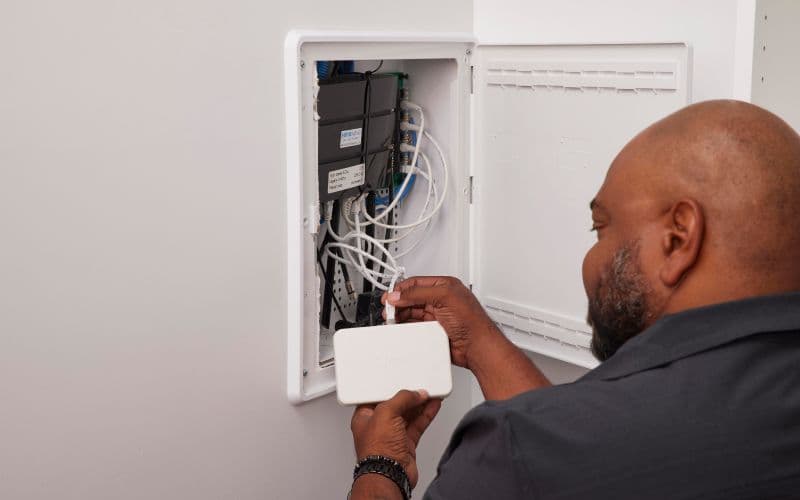July 01, 2024
Managed WiFi Myth Busting: Why It’s Not the Backbone of a Smart Apartment

Key takeaways:
- You don’t need managed WiFi to enable your smart apartment platform
- WiFi is not the best connectivity model for most smart apartment technology
- The most reliable network connectivity is the one that is designed to fit the exact needs of your property
There’s a common misconception in multifamily that you need managed WiFi to take advantage of smart technology. But that’s not true — you need connectivity. And there’s a significant difference between the two.
Deconstructing the managed WiFi buzz
In the 2024 20for20 survey of multifamily owners, Dom Beveridge noted that “managed WiFi was the main story in connectivity as it grows in popularity.”
Today, owners and operators are making the decision to implement managed WiFi in their communities for two primary reasons:
- To deliver a seemingly in-demand amenity
- To enable the community-wide smart tech solutions they’re investing in
But let’s break down why neither scenario actually necessitates managed WiFi.
First: Residents want internet access, not necessarily managed WiFi. In fact, a 2024 survey conducted by Parks Associates reveals that renters ranked ‘having the choice of more than one internet provider’ as more important than ‘having internet service provided by the property,’ indicating that internet access in general is more important to renters than managed WiFi.
Second: smart tech doesn’t require managed WiFi.
You don’t need managed WiFi to take advantage of smart tech
Many in multifamily assume that implementing smart tech requires adding managed WiFi. In an existing building, that means upgrading the building’s broadband infrastructure.
But connectivity — not internet — is the fundamental requirement for smart apartment technology. Managed WiFi is just one of a few methods of connectivity, and it’s usually not the most reliable or the most cost-effective option for smart tech.

3 reasons why managed WiFi can’t be the backbone of your smart apartment platform
Investing in a smart apartment platform doesn’t mean you can’t also add managed WiFi. But enabling smart tech shouldn’t be your impetus for implementing managed WiFi.
1. WiFi isn’t optimized for battery-powered devices
Smart devices can either be battery-powered (typically smart locks, leak sensors, door sensors, and motion sensors) or line-powered (light switches, dimmers, and most thermostats).
The ideal smart tech package includes both line-powered and battery-powered devices, so you need a connectivity model that can accommodate both.
But WiFi isn’t the right technology to connect battery-powered devices.
First, WiFi generally consumes more power compared to other wireless communication protocols like Zigbee or Z-Wave. In a multifamily building with potentially hundreds of battery-powered devices, that high energy consumption means more time and money spent replacing batteries.
Additionally, WiFi devices weren’t designed with multifamily in mind. They aren’t easy to manage as a fleet in a multifamily environment, where devices need to be easily reset and made ready for the next incoming tenant.
2. WiFi connectivity has signal constraints
Signals with wireless technologies like Z-Wave and Zigbee — which were specifically designed for device connectivity — extend further than WiFi, especially through walls. WiFi router placement and the distance (and number of walls) between devices and the router dramatically impact the signal and therefore the reliability of the connection.
Anyone with WiFi in their home knows how frustrating it can be to have a poor connection when they’re a couple rooms away from the router.
Additionally, when you’re using managed WiFi as your smart tech connectivity network, bandwidth is shared across the building, which can impede connectivity.

3. WiFi isn’t the most cost-effective connectivity method
Upgrading your building’s broadband infrastructure to accommodate managed WiFi can be capital-intensive.
For example, a property with a coaxial infrastructure (common of structures built in the early 2000’s) won’t have the pre-existing cabling required to implement managed WiFi. And installing the necessary cabling is often cost-prohibitive — at a 200-unit community, a turnkey solution could easily cost between $250,000 - $300,000.
There’s also the dilemma of existing retail internet contracts. If you’re already under contract with an internet provider, it can be extremely expensive to get out of.
Recommendations if you’re considering managed WiFi
Before diving headfirst into a managed WiFI investment, consider your overall goals for your property.
By decoupling smart tech investment decisions from managed WiFi investment decisions, you’ll be better positioned to make smarter and more cost-effective upgrades to your property.
You’ll also ensure that any smart tech you do invest in is supported by the most reliable connectivity model for your property — which might not be WiFi. Explore connectivity alternatives by partnering with a trusted expert who can design a network infrastructure that meets your property’s exact needs.
When recommending and designing a network infrastructure, your smart tech partner will account for:
- Unit density and floorplan size
- Building count
- Infrastructure, availability, and location of IDF, MDF, electrical, mechanical, or general closets
- Internet delivery method
- Particular devices you are hoping to install in your property
Ultimately, there’s no one right connectivity model — every building is different. Investing in smart tech doesn’t require managed WiFi, but it does require thinking deeply about the fundamental platform that will support your smart devices.
Insights from the field
Explore work and research reflecting over a decade worth of experience and leadership in the multifamily space.


























